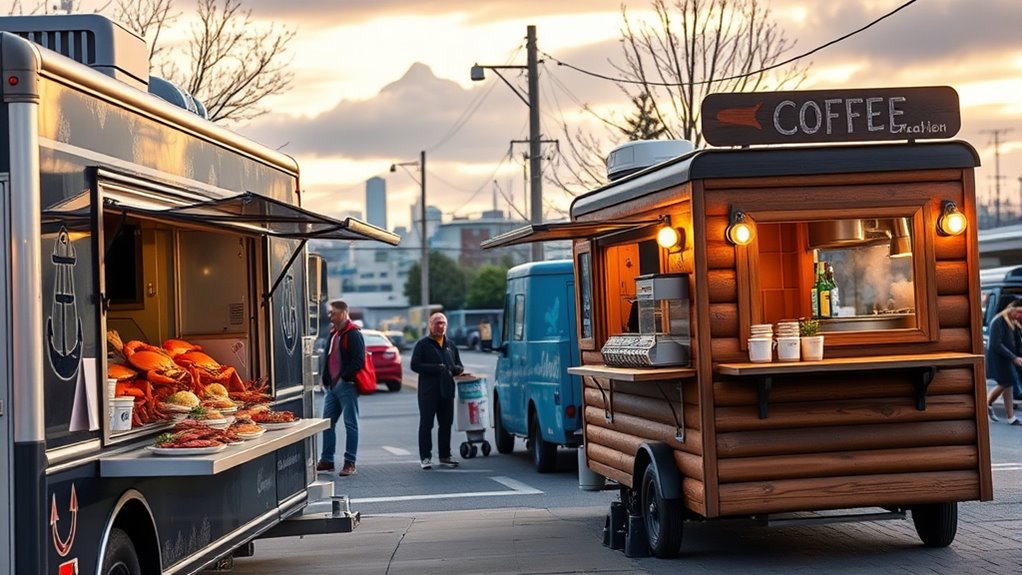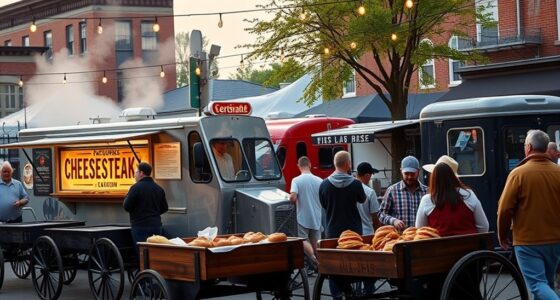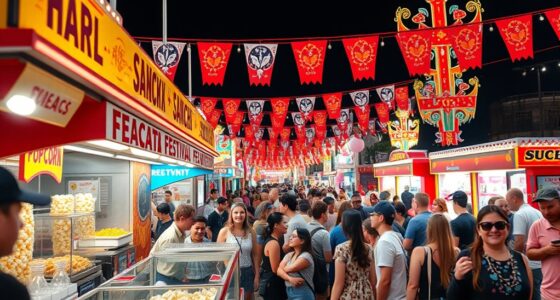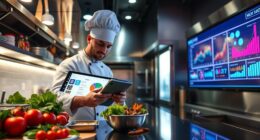Seattle’s food trucks blend fresh, sustainable seafood with global flavors like Asian, Latin, and regional influences, creating vibrant, versatile menus. They also showcase a thriving coffee scene with craft brews, mobile cafes, and technological innovations that enhance convenience and safety. As regulations evolve and customer preferences shift toward health and affordability, these trucks continue to innovate. To discover more about this dynamic scene, explore how local culture and technology shape Seattle’s seafood and coffee trucks.
Key Takeaways
- Seattle’s food trucks feature diverse seafood dishes emphasizing sustainability, regional ingredients, and innovative cooking techniques like wood-fired and quick frying.
- Fusion cuisines combining Asian, Latin American, and local flavors create vibrant, cross-cultural seafood and coffee offerings.
- Artisanal coffee trucks prioritize high-quality, ethically sourced brews with technological innovations like mobile ordering and contactless payments.
- New regulations and infrastructure improvements support transparency, safety, and operational efficiency for seafood and coffee vendors.
- Consumer preferences for affordable, diverse, and health-conscious options drive continuous innovation and growth in Seattle’s mobile food scene.
The Rise of Seafood Offerings on Seattle Food Trucks
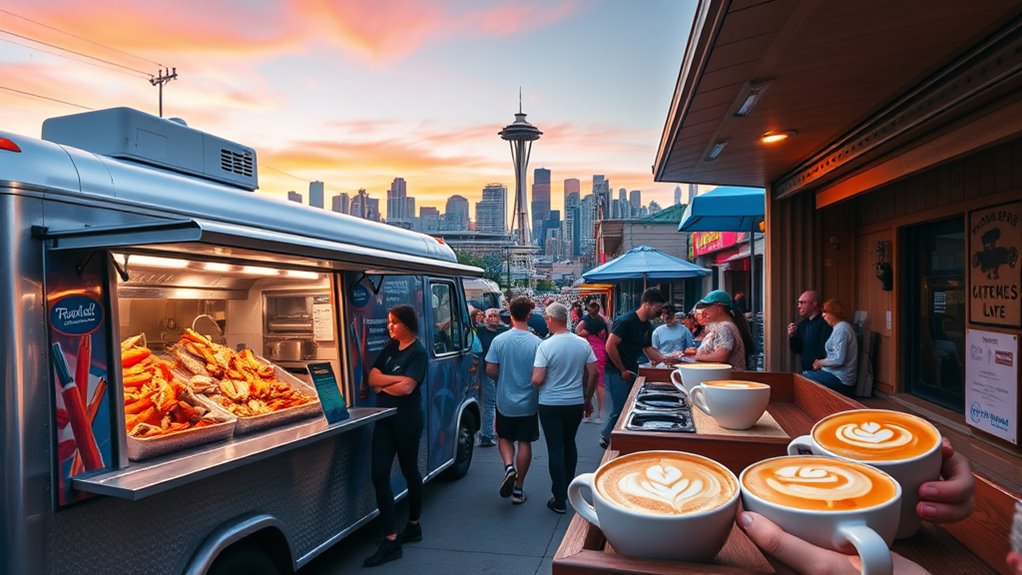
Seattle’s vibrant street food scene has seen a notable increase in seafood offerings on food trucks, reflecting both the city’s coastal location and its culinary innovation. With over 300 food trucks daily, seafood is a standout category, drawing locals and tourists alike. Many trucks serve traditional dishes like fish tacos and clam chowder, but they do so quickly and conveniently, fitting street food culture. These trucks leverage Seattle’s reputation for fresh, wild-caught seafood, often highlighting sustainable options like Alaska Pollock. They emphasize local ingredients, offering daily catches and regional shellfish, which appeal to eco-conscious diners. As seafood trucks grow in popularity, they become key players in the city’s culinary scene, blending quality, sustainability, and accessibility in every bite. Additionally, the use of locally-sourced ingredients enhances the freshness and authenticity of these offerings, ensuring that diners experience the true flavors of the Pacific Northwest.
Innovative Fusion: Blending Global Flavors With Local Seafood
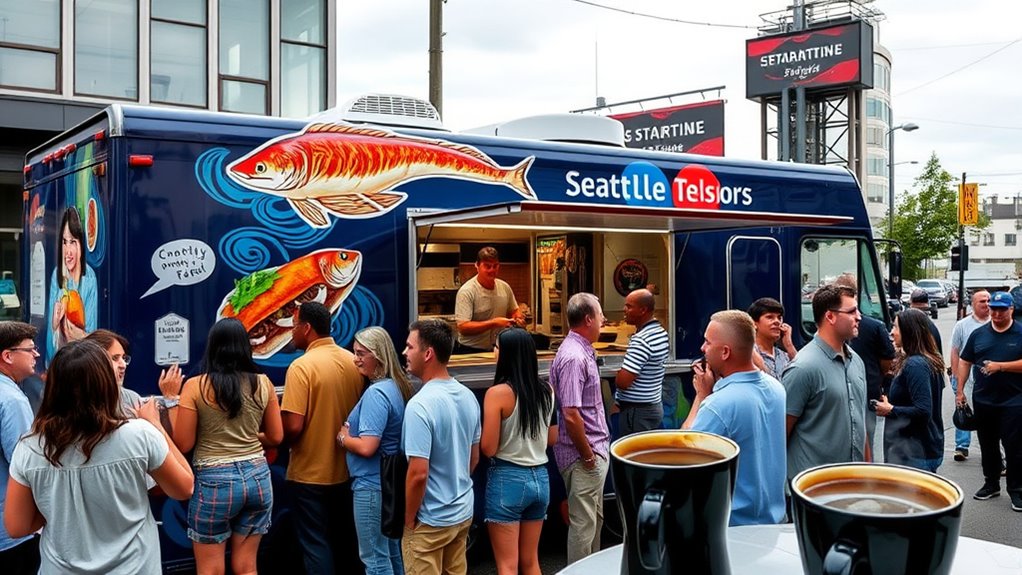
Seattle’s food trucks are mixing global flavors with local seafood to create exciting, innovative dishes. You’ll find everything from Asian-inspired fish tacos to Latin-seasoned clam chowder that reflect the city’s multicultural vibe. These fusion creations showcase how international culinary traditions enhance Seattle’s rich seafood scene. By experimenting with visual language, these chefs are elevating the art of food presentation and storytelling through their inventive dishes.
Global Culinary Crossovers
Global culinary crossovers are thriving in the city’s vibrant street food scene, where local seafood becomes a canvas for international flavors. You’ll find Pacific Rim influences, blending Hawaiian, Japanese, Filipino, and broader Asian cuisines into innovative seafood dishes. Filipino-Asian fusion trucks like Fil Up showcase the fusion, while nearby Bellevue’s SuperKim Crab House offers Thai and Cajun seafood boils, emphasizing cross-cultural creativity. Spices and techniques from Southeast Asian and Pacific cuisines add complexity to traditional seafood. Latin American and Caribbean influences also shine, with trucks like Garzon Latinx serving seafood bowls and tacos flavored with cumin, chili, and smoked paprika. Seattle’s food trucks masterfully combine global flavors with local seafood, creating vibrant, multicultural dishes that excite your palate and celebrate culinary diversity. Incorporating multicultural culinary techniques enhances the richness and authenticity of these fusion dishes, making each bite a unique experience.
Local Seafood Innovations
Innovative seafood preparations in local food trucks showcase how regional ingredients can be transformed through creative techniques and global influences. You’ll find Pacific Northwest favorites like salmon, lingcod, Dungeness crab, and geoduck prepared with modern methods such as wood-fired cooking and quick frying, emphasizing freshness and flavor. Unconventional ingredients like seaweed and kelp are used in breads, sauces, and garnishes, adding unique textures and umami notes. Dishes like lobster rolls, fried soft-shell crab bags, and shrimp and grits blend casual American styles with artisanal touches, making seafood approachable yet sophisticated. Many trucks highlight sustainable sourcing, emphasizing transparency and seasonal choices. The use of microgreens, sea vegetables, and innovative condiments elevates these offerings, creating a vibrant, eco-conscious seafood scene that celebrates regional flavors with a creative twist. Additionally, regional diversity of ingredients allows chefs to experiment with a variety of preparations, enriching the local culinary landscape.
Seattle’s Coffee Culture: Mobile Vendors and Specialty Brews

You’ll notice that artisanal coffee trends drive many mobile vendors to offer unique, high-quality brews that appeal to Seattle’s discerning drinkers. Technology plays a key role, with mobile ordering and digital payments speeding up service and enhancing customer experience. By combining craft craftsmanship with tech innovations, vendors create a seamless, personalized coffee experience on the go. Additionally, some vendors utilize color accuracy techniques to ensure their branding and packaging reflect the high-quality standards of their beverages.
Artisanal Coffee Trends
Seattle’s artisanal coffee scene is thriving with a focus on craftsmanship, quality, and community. You’ll find independent cafés and small-batch roasters in neighborhoods like Capitol Hill, Ballard, and Fremont, serving single-origin beans and innovative brews. Notable roasters like Victrola Coffee, Seattle Coffee Works, and Lighthouse Roasters emphasize transparency, ethical sourcing, and sustainability. Baristas craft a variety of drinks, from pour-overs and flat whites to nitro cold brews and honey-infused options. They often highlight unique flavor profiles from specific farms, maintaining direct relationships with farmers for traceability. These cafés blend traditional techniques with modern innovation, creating signature beverages and hosting tastings. More than just coffee spots, they serve as community hubs that foster local culture, education, and connection through a shared passion for quality and responsible sourcing. Additionally, many of these venues incorporate cookie consent strategies to enhance user experience while respecting privacy.
Tech-Driven Service Innovation
Mobile vendors in Seattle have transformed the local coffee scene by leveraging advanced ordering and payment technology. You can now use mobile apps and online payment platforms to order quickly, reducing wait times and speeding up transactions. These systems also boost sales by making the customer experience seamless, especially when integrated with loyalty programs on familiar third-party apps. Pre-ordering features help you plan ahead, improving inventory management and efficiency for vendors. Strategically, vendors rotate locations around high-traffic areas like parks, offices, and schools, and form partnerships with property managers and local businesses to expand their reach. Participation in community events and catering services also increase visibility and revenue, meeting the demands of busy Seattle professionals and students who crave specialty, sustainable coffee options. Additionally, understanding data management and dynamic updates can help vendors optimize their locations and offerings for better customer engagement.
Tech-Driven Trends Enhancing Food Truck Operations
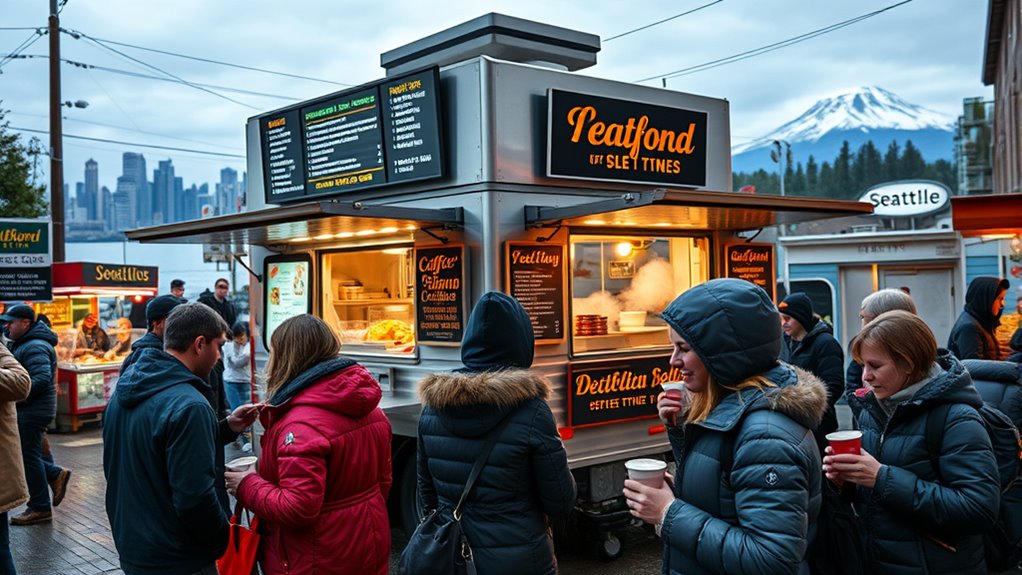
Advancements in technology are transforming food truck operations by making them more efficient, engaging, and sustainable. You can now leverage tools that optimize every aspect of your business. For example:
- AI-powered management systems predict demand, streamline inventory, and cut waste.
- Automated cooking tech, like smart fryers, ensure consistent, high-quality food.
- Cloud-based POS systems track inventory, process payments, and forecast sales remotely.
- AI-driven ordering with QR codes and voice recognition simplifies customer interactions and reduces errors.
- Technology adoption also enables real-time data sharing between trucks and supply chains, improving responsiveness and reducing delays.
- Understanding store hours can help you plan your shopping trips to avoid busy periods and ensure product availability.
These innovations boost operational efficiency, improve customer experience, and support sustainable practices. Geofencing alerts nearby customers, while GPS tracking helps them locate your truck easily. Embracing these trends keeps you competitive and responsive in Seattle’s vibrant food truck scene.
Navigating Regulations and Supporting Small Businesses
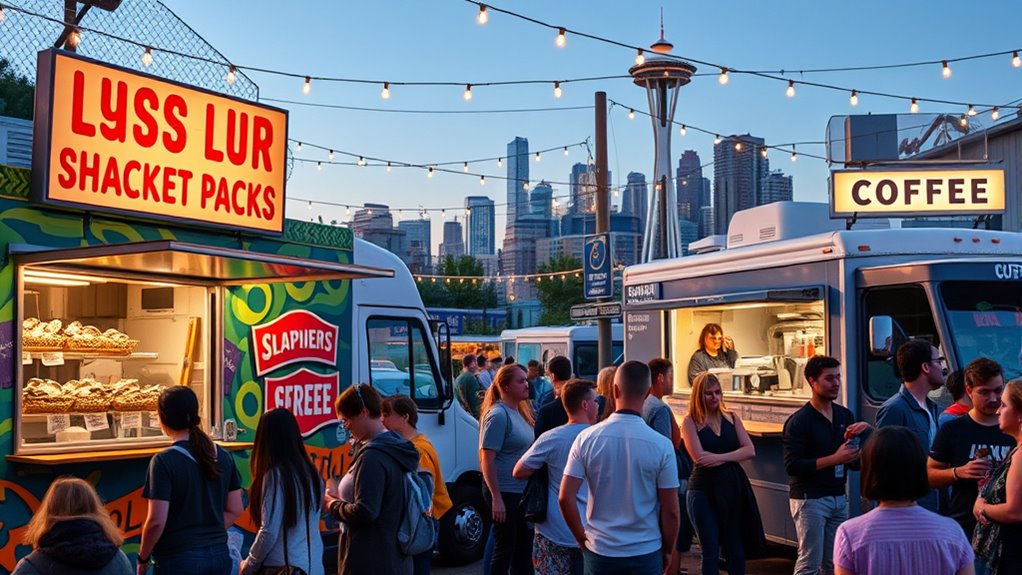
Tracking the complex regulatory landscape is essential for small food truck businesses to operate legally and thrive. You must obtain permits, submit detailed plans, and pass multiple inspections. King County requires food safety rating placards on a four-tier scale, starting January 1, 2025, to boost transparency. You’ll need approval from Washington State L&I, along with fire safety inspections coordinated statewide, which helps you avoid duplicative efforts. The process includes plan reviews that can take 4-8 weeks, ensuring your operation meets safety and health standards. Displaying excellent ratings can attract customers and build trust. The table below summarizes key requirements:
| Step | Details |
|---|---|
| Permits | King County, L&I approvals |
| Inspections | Fire, health, safety checks |
| Rating | Visible food safety placards |
Supporting regulations protect your business and consumers alike. Incorporating regulatory compliance into your planning can help streamline the approval process and prevent potential setbacks.
Consumer Preferences Shaping the Food Truck Scene

Consumer preferences are rapidly shaping the food truck scene in Seattle, especially among Millennials and Gen Z who prioritize affordability, variety, and convenience. These groups seek meals priced between $10 and $15, with a focus on fresh, customizable, and globally inspired options. They also favor health-conscious choices like plant-based and vegan dishes, along with seasonal menus that create a sense of exclusivity. To stand out, food trucks are blending cuisines, such as Korean-Mexican or Cuban influences, and offering innovative coffee and seafood pairings. Additionally, trucks leverage data to refine menus and pricing, while positioning near busy areas and embracing mobile ordering for quick, seamless service. The food truck industry in Seattle has seen a consistent annual growth rate of approximately 8% over the past five years, ultimately, their preferences drive a vibrant, diverse, and customer-focused food truck culture in Seattle. Incorporating cultural influences helps trucks appeal to a broader audience and enhances the overall dining experience.
Future Outlook for Seafood and Coffee Trucks in Seattle
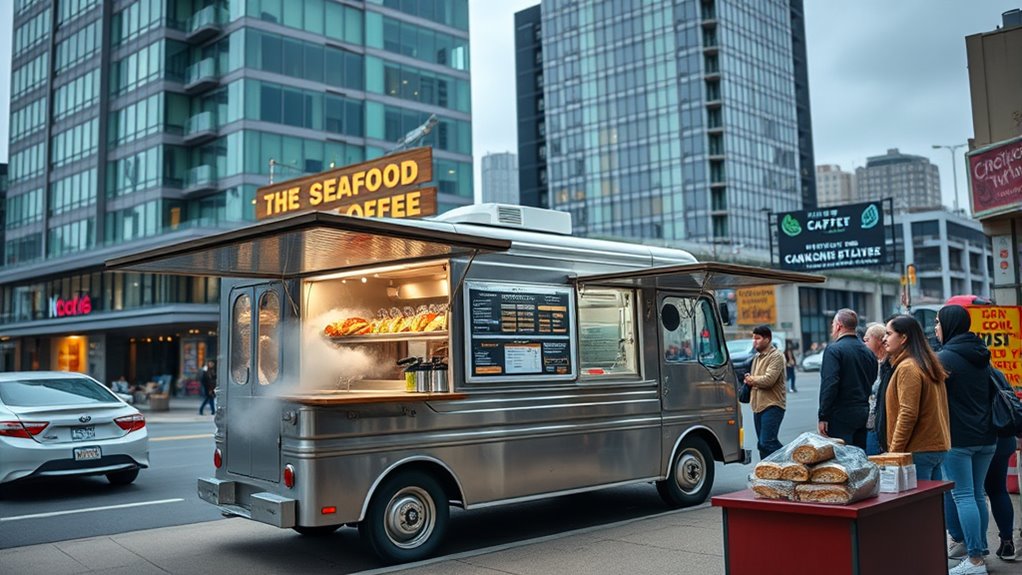
Regulatory changes set to take effect in 2025 will substantially shape the future of seafood and coffee trucks in Seattle. King County’s new requirement for health inspection rating placards will boost transparency and consumer trust, encouraging higher safety standards. The certified Food Protection Manager mandate ensures a responsible individual oversees food safety, supporting quality control. Compliance with Washington State’s Retail Food Code and approval from Labor & Industries will streamline operations but may increase costs and processing times. Infrastructure improvements, like licensed commissary kitchens, will enhance food prep and storage, maintaining freshness and quality. Technological advancements, such as improved temperature controls and contactless payments, will boost efficiency. Overall, these changes will foster a safer, more sustainable, and competitive environment for seafood and coffee trucks to thrive in Seattle’s vibrant food scene.
Frequently Asked Questions
How Do Food Trucks Ensure Sustainable Seafood Sourcing in Seattle?
You can guarantee food trucks in Seattle source sustainable seafood by checking if they use Seafood Watch ratings and prefer local, transparent suppliers. Look for trucks partnering with certified sustainable fisheries or practicing responsible harvesting methods like trap fishing or hand harvesting. Many also prioritize eco-friendly packaging and contactless sales, reducing waste and environmental impact. Supporting these trucks helps maintain healthy ecosystems and strengthens local fishing communities.
What Are the Most Popular Coffee Brewing Methods Used by Mobile Vendors?
You’ll find that traditional drip coffee brewers are most popular for mobile vendors because they’re fast and simple, with fresh beans ground every 40-45 minutes. Many also use espresso machines for high-quality drinks like lattes and cappuccinos, though they require more attention. Cold brew and slow drip methods are also gaining popularity, offering smooth, less acidic options that are ideal for quick service and hot weather.
How Do Food Trucks Adapt to Limited Infrastructure at Park Locations?
Did you know that over 60% of food trucks in Seattle operate in parks with limited infrastructure? You adapt by using self-powered kitchens, onboard utilities, and portable waste systems. You choose sites carefully to avoid blocking pathways or essential services, often operating during peak park hours to minimize disruptions. Solar panels and compact layouts help you stay environmentally friendly and flexible, ensuring you can serve in diverse park settings without relying on extensive infrastructure.
What Are the Key Challenges for Minority-Owned Seafood and Coffee Trucks?
You face significant hurdles as a minority-owned seafood or coffee truck in Seattle. Steering complex regulations, securing permits costing over $28,000 annually, and accessing capital are tough barriers. Limited locations, fierce competition, and infrastructure gaps make it hard to maintain quality and attract customers. Language and informational barriers add to the challenge, making it difficult to grow and sustain your business in a competitive environment.
How Is Customer Feedback Integrated Into Menu Innovation for Seattle Food Trucks?
Think of customer feedback as your compass guiding menu innovation. You actively collect opinions through suggestion boxes, social media polls, and digital surveys, then swiftly adapt your offerings based on those insights. By introducing small batches of new dishes, leveraging seasonal ingredients, and using AI analytics, you stay receptive to customer desires. This continuous loop of listening and adjusting keeps your menu fresh, relevant, and ensures loyal patrons keep coming back for more.
Conclusion
As you explore Seattle’s vibrant food truck scene, you’ll discover a city that’s truly riding the wave of culinary innovation. From fresh seafood to expertly brewed coffees, these trucks offer more than just a meal—they deliver a taste of local passion and creativity. So, don’t miss out on these hidden gems; they’re the heart and soul of Seattle’s food culture. When it comes to flavor, you’re really getting the cream of the crop.
